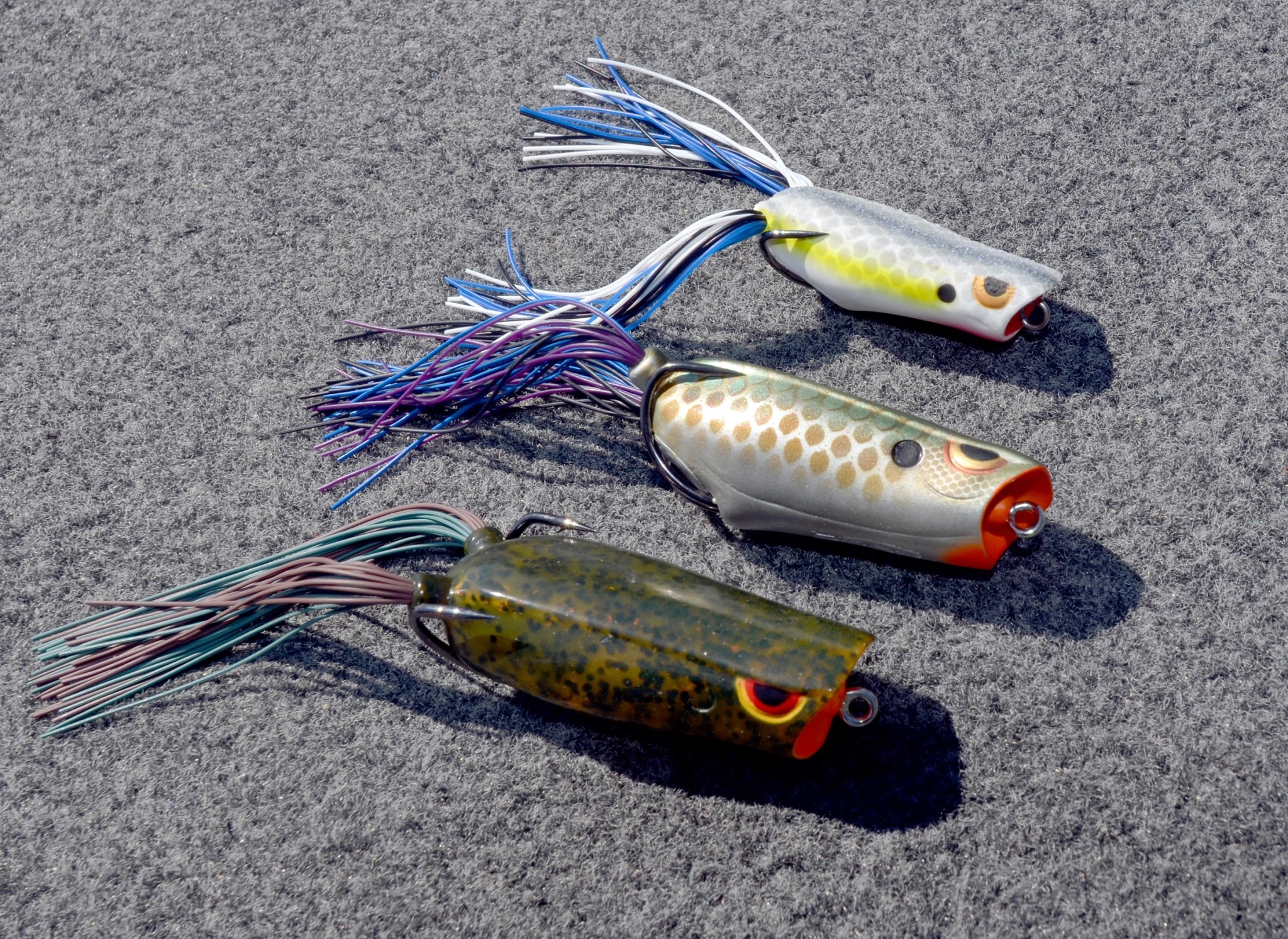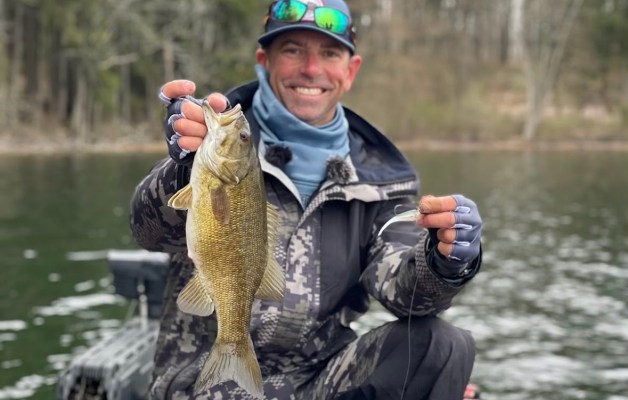
You don’t always get a clear look at them, but those shimmering streaks that plink and plop into the lake when you approach are one of the largemouth bass’ favored meals. We’re talking frogs, and when it comes to bank fishing, few baits can top this amphibian’s impersonator — the hollow-body topwater frog.
Sure, you’re limited to surface presentations, so a “down bait” — I like a Texas-rigged Senko — makes a helpful complement. But when space or budget limits you to a single rod, or if you’re on a lunch break or sundown stroll, you’ll be hard pressed to find a more entertaining bait.
For anglers of all ages, the highly visual nature of frog fishing perpetuates the fascination. You’re constantly learning to advance your casting and retrieving skills simply by watching the bait’s motion in various scenarios and noting what combination of details drew that strike.
The overall action level may be less frequent than you might experience with subsurface baits, but a frog bite is pure adrenaline. Suffice it to say, the majority of fish that commit to a topside bite bring the heat.
There’s no fooling around: no nudging, nibbling, pondering. Once second, your frog is traipsing across the surface, and then KABLOOSH! — it disappears in a violent explosion known to drive experienced fishermen into temporary, knee-lifting, fetal positioning stasis.
Don’t worry, you’ll survive, and don’t sweat the nearly inevitable overreaction. Most anglers will miss a few each trip until the nerves settle and you dial in your measured response.
Jumping ahead a little bit, Bassmaster Elite Series angler Drew Cook offers this hook set advice: “My rule of thumb is ‘know that the fish has got your frog before setting the hook.’ Either you can see that your frog is not there, or the fish is pulling your rod down.
“When you see the blow up, you don’t want to immediately respond, because hesitating might give you maybe two seconds to see if he missed it. If you leave the frog where it is, the fish might come back and try to get it again.”
Where to throw it
Peppering laydowns and cypress knees or skipping under docks is worth a shot, but frogs are ideal for shallow vegetation. Aquatic plant mix varies by fishery, but whatever your pond offers, look for the reachable areas with enough water to sustain a fish population and enough holes, gaps and spacing for a fish to reach a surface meal.
Ask any seasoned angler and they’ll tell you that the duckweed often growing right near the bank offers the absolute best frogging habitat. That’s because the tiny, semi-round leaves form a tight carpet that offers bass complete coverage. However, busting through the thin and easily separated leaves is like sticking your finger through a bowl of whipped cream — no resistance.
For any shoreline habitat, mind your angles and realize that casting from shore means a deep-to-shallow retrieve. Depending on seasonality, this can increase or decrease opportunities.
Spring finds big fish moving shallow for the spawning cycle, while summer and winter extremes often find them in deeper, cooler water.
Look for sweet spots
Lacking a boater’s range and mobility, the bank angler’s time efficiency starts with prudent targeting. Any field of reachable vegetation is fair game, but focus on fish-friendly features like cuts, holes, points, secondary structure — stumps, laydowns — and shoreline features that direct bait flow and maintain leeward protection.
Canal or creek mouths are great transition points where current dynamics create good shoreline opportunities. Elsewhere, publicly accessible retention ponds with year-round depth and weedy areas can be overlooked and underutilized gems.
In those stormwater management bodies, as well as natural lakes and ponds, drain pipes skirted by vegetation present the closest thing to a slam dunk as the shore-bound frogger will find. Current always attracts bass, but the rush of stormwater brings a sudden food bounty, while disorienting local forage.
Personal account: A small neighborhood drain pipe dumps into the lake behind my property, and when big summer rains crank up the volume, an insane frog bite ensues. Every year, usually around mid-July, the deal gets right, and I’ll take goofy selfies with a handful of thick ones.
From a boat, or kayak, I’d want to position downcurrent, cast toward the pipe and mimic something flowing naturally, but my access is nearly parallel to the pipe, so I try to hit the slack water ambush spots along the water’s course. A dock piling, points in the adjacent pads, a duckweed mat the size of a backpack pushed into a grass line divot — all money spots.
And don’t hesitate to lob a frog into blind spots — gaps and likely ambush points obscured by docks, vegetation, etc. Case in point, one year, the vegetation grew thick around my local drain pipe, but I could tell there was a little pocket of open water right next to the outfall.
Facing the flowing pipe, I made a short lob cast that dropped my frog into the opening behind the grass. I immediately heard the telltale “smack” that told me to reel down and lay the wood to him. An honest 7-pounder waiting for an easy meal got her picture taken.
Further exemplifying bank-friendly opportunities, Cook’s keen on skipping his frog under overhanging willow trees, especially when a mayfly hatch brings concentrated focus. Often, it’s bream eating the flies, but when opportunistic bass slide in to pick off distracted bream, a popping frog gets a lot of love.
Frog selection
Choose your frog based on habitat density. Generally, a popping frog excels in sparse grass and open water adjacent to cover, while a traditional narrow-nose frog serves you best in thicker habitat like lily pads, spatterdock, reeds and anything that impedes the forward motion.
Remember, from a boat, the higher rod position allows anglers more upward influence to navigate a frog through the thick stuff. From the bank, it’s more of a straight line pull, so narrow noses traverse obstructions better than a concave popper.
A standard size frog like the iconic SPRO Bronzeye 65 or Bronzeye Pop 60 will cover the majority of your bank fishing duties, but keep a few tiny frogs, like the 1 1/2-inch, 1/5-ounce SPRO Pop 40 handy for tempting the tougher bites.
Elite pro Kyle Welcher notes, while plenty of juvenile frogs end up in bass bellies, these apex predators also eat a lot of bugs. Moreover, from Minnesota to Texas, anglers often find bass gulping tiny inch-long baitfish and ignoring full-sized baits.
Standing closer to the water, bank anglers are often quick to spot this tiny forage. Add shallow shad spawns and postspawn fry guarders to the mix, and the downsized frog might be your day-maker.
Strategic adjustments
Most modern frogs work pretty good right out of the package, but Cook suggests trimming the legs to minimize drag and facilitate rod tip response. As he notes, trimming one side about an inch shorter creates an exaggerated saunter that boosts the appeal.
Note: If the fish are consistently short striking, further shorten the legs, or remove them entirely. Bass are often watching for shadows and broken shapes crossing overhead cover, so their aim lacks precision. Those frog legs are mostly for show, so bringing the bite closer to the hook points always helps.
“I also like to add BBs (or shotgun pellets) to my frog through the leg holes,” Cook said. “This makes a rattling noise that helps the fish locate my bait in thicker cover.
“Also, the rattles make the frog heavier, so it sits lower in the vegetation. This makes a deeper impression over thick cover and helps the bass find it.”
Welcher offers this advice: “A full-size frog has so much flotation that when you trim the legs it doesn’t really affect the action too much. A small frog doesn’t have that much flotation, so you really want to leave it close to the original form.”
Tackle tips
Cook recommends a 7-foot-3 medium-heavy rod with a moderate fast tip. Some like heavy-power frog rods, but Cook believes a little “give” affords him just enough buffer to let the fish get the bait, while minimizing the risk of him pulling it away.
Higher reel speeds are a must for quickly gathering line and firing off another cast — especially when you miss a fish or you see one blow up where your frog is not.
Considering the cover around which most of your frogging will occur, baitcasting gear and 50- to 65-pound braid is the way to go. A hooked fish will do its best to bury into the cover, but braided line will cut through a lot of the gunk.
The obvious exception here is that tiny frog option. Given the bait’s featherweight form, you’re not going to get much distance with stout baitcasting gear. Welcher throws his SPRO Pop 40 on a 7-3 medium-heavy spinning rod with 20-pound braid
Wherever and however you fish a frog, this is unquestionably one of the most addictive ways to engage largemouth bass. Choose your spot wisely and expect a thrill.





